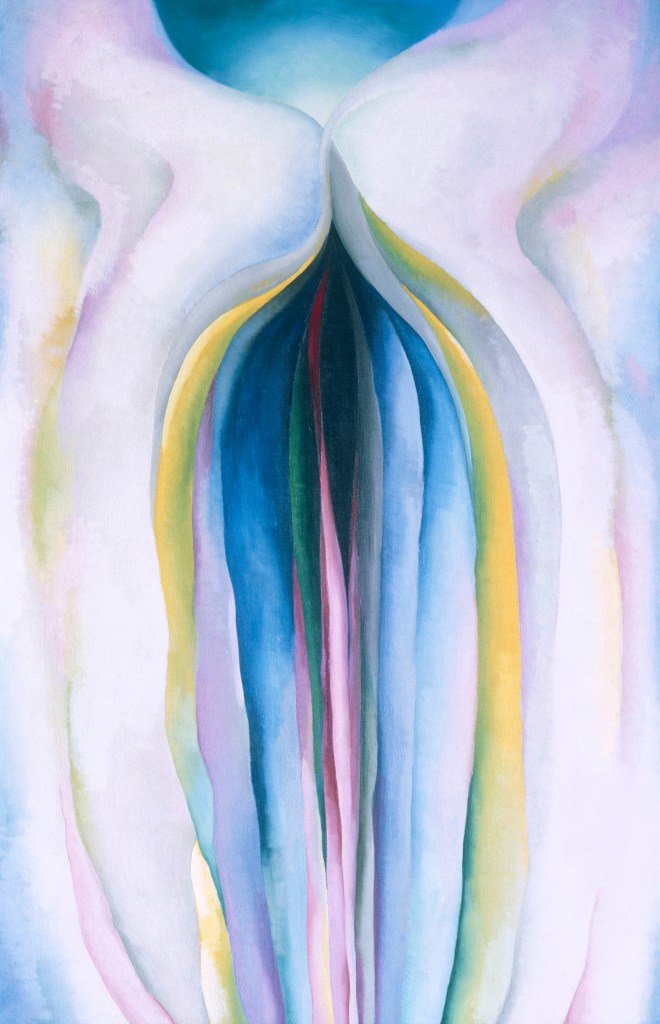In Mary McCarthy’s The Group (1963), a novel set amid the bohemian swirl of 1930s New York, there’s a minor character whose tastes are telling: she’s having an affair with a married man, has a dog called Nietzsche, and on the walls of her apartment are ‘framed reproductions of Georgia O’Keeffe’s vulval flowers’. Though it’s no longer such a symbol of modernity and sexual liberation, O’Keeffe’s art is still clouded by the discussions of gender that have tended to limit our understanding of her achievement. In the 1920s, male critics influenced by Freud offered a largely sexualised account of her early paintings, seeing them as a distillation of modern womanhood, while in the ’70s she was reclaimed by feminists such as the artist Judy Chicago, who welcomed her work’s links with the female body. Today, O’Keeffe’s career is still often reduced to those ‘vulval flowers’ and their apparent depiction of female genitalia.
O’Keeffe (1887–1986) remained vehemently resistant to such readings – in 1939 she accused her male critics of hanging ‘all your own associations with flowers on my flower’ – and Tate Modern’s summer blockbuster, the largest retrospective of the artist to be held in the UK, is an attempt to shatter such outdated interpretations. The flower paintings make up a small number of the 100 works on display in a show that travels from O’Keeffe’s early charcoal abstractions to her later studies of bones and depictions of the dusty, vast landscape of New Mexico. It’s hard, though, to get past the stereotypes: from the watery openings and folds in Grey Lines with Black, Blue and Yellow (c. 1923) to the smooth rusted creases of New Mexico hills, her work frequently invokes female anatomy.
Grey Lines with Black, Blue and Yellow, c. 1923, Georgia O’Keeffe. Museum of Fine Arts, Houston © 2016 Georgia O’Keeffe Museum/DACS, London

O’Keeffe’s early critical reception was in fact fuelled by her gallerist, and eventual husband, Alfred Stieglitz. On first encountering the 29-year-old O’Keeffe’s charcoal works – strange compositions of curling forms and black lines – Stieglitz declared, ‘At last, a woman on paper!’ He gave her a solo show the year after, in 1917, and these works are displayed in the opening gallery here in a recreation of Stieglitz’s 291 space in New York; from these follow a selection of Steiglitz’s portraits of O’Keeffe, including images of her breasts, hands and pubic hair (but none, significantly, of the artist at work). Hung here, the photographs have the effect of turning the subject of this exhibition into an object.
This immediate biographical focus puts O’Keeffe’s relationship with Stieglitz centre stage. The couple’s artistic dialogue is well documented, and Tate’s hang draws out the overlapping subject matter: trees, apples, and clouds; her dizzying New York Street with Moon (1925) and his hard-edged New York from an American Place (1931), snapped from the apartment they shared on the 30th floor of the Shelton Hotel. Taken together, O’Keeffe and Stieglitz present a version of American modernism, rooted in the wider circle of progressives who were driven by the search for a new national artistic identity. O’Keeffe was committed to what she called ‘the Great American Thing’ and the exhibition’s thematic focus makes clear her loyalty to the American landscape. It’s a coup that Tate has gathered so many of O’Keeffe’s rarely seen Lake George works, made during a high point in her career: nature takes over in From the Lake No. 1 (1924), as ribbons of greens and blues play with the horizon to hint at tree and sky.
From the Lake No 1, (1924), Georgia O’Keeffe. Des Moines Arts Center, Iowa © 2016 Georgia O’Keeffe Museum, DACS, London

O’Keeffe’s engagement with place played out more dramatically after her first visit to New Mexico in 1929, which liberated the artist, and not just from Stieglitz – ‘As soon as I saw it, that was my country.’ Canvases such as the muscular Red and Yellow Cliffs (1940), capturing the pink and yellow earth that rose upwards from her backyard at Ghost Ranch (where she purchased a house that year), fixes the artist firmly in that mountainous landscape – far away from the built-up urban sprawl of Manhattan. The bones in works like Summer Days (1936) that O’Keeffe painted following her discovery of the south-west are, however, repetitive and kitsch – in part a result of their pasty, washed-out tones. Yet they are also indicative of O’Keeffe’s search for new imagery in a barren landscape.
Crucially, the exhibition reveals more broadly how photography shaped O’Keeffe’s work as she experimented with cropping, flattening, foreshortening, and close-ups. While her flowers and leaves frequently play with scale, landscapes such as Purple Hills (1935) and The Mountain, New Mexico (1931) are zoomed in and cropped to the point of abstraction. It’s clear too in O’Keeffe’s later ‘Black Place’ paintings from the 1940s. From her house in New Mexico, O’Keeffe would often journey west to a dramatic terrain that featured a stretch of dark isolated cliffs. O’Keeffe’s radical works here suggest a total immersion in this rough landscape; in Black Place III (1944), a serrated fissure disrupts the angular roll of the hills. Writing about their strangeness to Stieglitz in 1943, she noted: ‘Those black hills…have something of a photograph about them.’ In her Pelvis series (1943–47), bones become apertures, framing a deep blue sky.
If anything, this exhibition stresses O’Keeffe’s commitment to looking, and to making others look; that people saw what she didn’t want them to is beside the point. In her essay on the artist, Joan Didion writes: ‘She is simply hard, a straight shooter, a woman clean of received wisdom and open to what she sees.’ It’s an attitude that makes O’Keeffe’s canvases as much about her as they are America. As that other committed modernist, her friend Marsden Hartley once said, ‘It is no small thing to stand for yourself. You do it.’
‘Georgia O’Keeffe’ is at Tate Modern, London, until 30 October.



